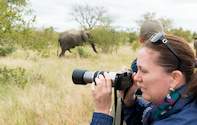
This Kruger Park Photography Guide suggests the best locations and routes for photography in this national park. Enjoy a photo safari and take amazing wildlife and birding pictures. You will treasure these mementos forever.
The Kruger National Park is legendary, known throughout the world for its diversity of species and dramatic landscapes, and the park has been depicted in many photographic coffee table books and image collections. With easy access to the park and a vast selection of accommodations and regions to choose from the Kruger Park is a photographers dream.
The diversity of habitats in the park, from open savannas to lush riverine forests, allows photographers the benefit of selecting preferred landscapes for their photographs. The animals in the park have adapted to the presence of vehicles which gives photographers many opportunities to get that special shot.
Photography Tips on Safari
On clear days, the best times for taking pictures are the first two hours of sunlight after dawn and the last two hours of daylight before sunset. The light then is soft, and gives pictures a "glow".
On overcast days, the opposite is true, with the best shooting time being from mid-morning to mid-afternoon. Using a flash on overcast days brings the subject up from the background.
Turn off your engine before taking pictures as the vibrations can cause images to blur. Likewise, when using telephoto lenses, make sure you have support for your camera so that your grip is steady. If you get close to animals, don't rush the pictures. The chances are that, if you're patient and persistent, you will get good-quality photographs.
Photographic Equipment
The Kruger park is the ideal place for amateur photographers and professionals alike and any size and make of equipment will bring results. In fact it is not uncommon to see people using their cellphones to take pictures, so close are the animals at times.
For the person wanting the best all round lens for the park then a 300mm lens is recommended to get those just out of reach images but the Kruger is truly the ultimate park for everyone when it comes to taking wildlife pictures.
Do's and Dont's of Photography in Kruger

- Respect the environment and wildlife
- Respect other patrons in the park
- Take only pictures and leave only memories
- Only alight at designated places
- Obey the Park rules - they are there for a reason
Stunning Scenery
There are a number of dramatic places in the park to stop and take photographs, including some where alighting from the vehicle is allowed. This adds to the attraction of Kruger as a great photographic destination.
A network of roads, known as drives, traverse the park and all provide something special for the photographer. Wooded savannahs open into grassland and scenic forest roads lead to rivers, with new delights at every turn.
On guided game drives, your safari guide will stop at scenic spots for you to take photos. You will also get a chance to take some amazing wildlife photos.

 This directory of Kruger Park game viewing routes provides a detailed description of drive-times, stop-over points and picnic sites between ...
This directory of Kruger Park game viewing routes provides a detailed description of drive-times, stop-over points and picnic sites between ... Informative and interesting game drives are conducted by experienced Safari Guides and are offered at Private Lodges or can be booked for Da...
Informative and interesting game drives are conducted by experienced Safari Guides and are offered at Private Lodges or can be booked for Da...